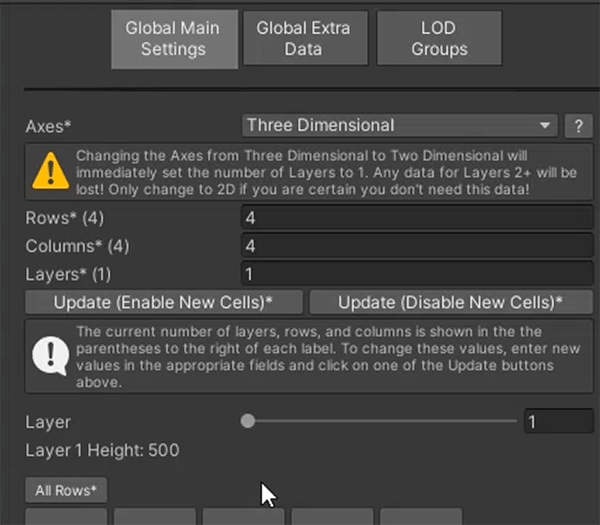

Whether you are an existing or prospective user, we welcome you to the documentation for SAM - The Streamable Assets Manager!
Prospective Users wondering what SAM is and how it works may be interested the Product Description page and our General Overview Video.
We recommended working through the Getting Started Tutorial Chapter followed by the Scene Conversion Tutorial Chapter.
Both of these tutorials are intended to be used with your existing scene(s), however if you currently don't have a scene to use, you can download the Sample Package from the Sample Packages Page, which includes an example scene you can use (Assets/Deep Space Labs/SAM/Samples/SampleScenes/BasicConcepts/5_Pre_SAM_Example_Scene).
If you are looking for the old Terrain Slicing functionality note that it has been split off into a separate product called Terra Slicer, which you should have access to. Simply search for Terra Slicer in the Asset Store (or use the link on our Terra Slicer Web Page) and add it to your cart. At checkout and the price should display as $0. Once you download Terra Slicer, please refer to the Terra Slicer Documentation for further instructions.
For those interested in dynamic streaming/SAM, I highly recommend that you go through this documentation in the same way that a complete newbie would (i.e., go through the Getting Started and Scene Conversion tutorials), with one addition. When you come to a bit of the guide that tells you to create a specific asset or component, you may come across an Upgrade Note. Read this note and click the link (if there is one) to see important information related to users who have upgraded! These links will take you to another page of the documentation found in the Upgrading Chapter, which will provide you with important information on how to upgrade the component/asset for the new system, or provide alternative/additional steps you need to take.
You can also take a look at the Upgrading Chapter before continuing, however this may be a little overwhelming.
You can work through the tutorials above using your existing MicroVerse scene or using the 2x2 Demo scene which is included in the MicroVerse Demo module. For other information, such as using the Roads module with SAM, please visit the Micro Verse page.
For existing users, do keep in mind that we have provided a tremendous amount of knowledge in the Inspectors themselves for various components/assets, via Tooltips.
Simply look out for an asterisk symbol (*) at the end of a Settings Label and hover over that label for detailed information about the Setting. Because this information is already located in a convenient location, we have endeavored not to repeat that information in this documentation in order to avoid redundancy.

While you may feel overwhelmed be the sheer size of this documentation, please understand that most users will never touch even half of it! SAM offers is a highly flexible and extensive system, and much of the documentation is spent detailing advanced features or offering instructions on how to customize it to fit their particular needs.
Other than the information found in the Getting Started and Scene Conversion Tutorials, most general information you need to know is outlined in the Tooltips (described above). However, if a particular component/system is unclear, you'll usually find a ? button in the inspector that will open this documentation to the Chapter/Section detailing information related to that system, component, or even a specific setting.
If you are someone that learns better by following pre-made sample scenes, we implore you to check out the ever growing library of Sample Scenes found in the Sample Packages Page. These Sample Scenes currently cover some of the more basic SAM concepts, but more will be added in the future!
The Samples Package also contains an example scene that you can use while working through the Getting Started and Scene Conversion Tutorials, for users who do not have any existing scenes to work with. This example scene is called 5_Pre_SAM_Example_Scene and can be found in the Assets/Deep Space Labs/SAM/Samples/SampleScenes/BasicConcepts folder after importing the package.
In addition to this Documentation, we have a comprehensive Public API available for users who wish to interact with SAM using scripting or extend certain components and Scriptable Assets.
If you find a bug, have a suggestion, or simply feel that this Documentation is lacking, please don't hesitate to use the Feedback link at the top of each Documentation Page, which will take you to the Contact Page with the Chapter and Section of the documentation pre-filled in the contact form.
This page also lists additional ways to contact us; feel free to use any method that you prefer!
--Special Note--
For more in-depth aid, your Invoice Number is required, so it is suggested to include that with your support requests (on the forums and Discord, provide this number separate from your support requests via a private or direct message, so as not to share this info with other parties).
If you have purchased SAM, you can become a Beta Tester by requesting it via one of the Contact methods and sending your Invoice Number for verification (Invoice Number should be sent privately!).
While testing and providing feedback is extremely helpful, at this time we are not enforcing any sort of testing/feedback requirements, and the invitation to become a Beta Tester is open to all customers (this may change in the future). As such, this is a great way to get access to updates faster than non-Beta Testers, who have to wait for Asset Store updates.